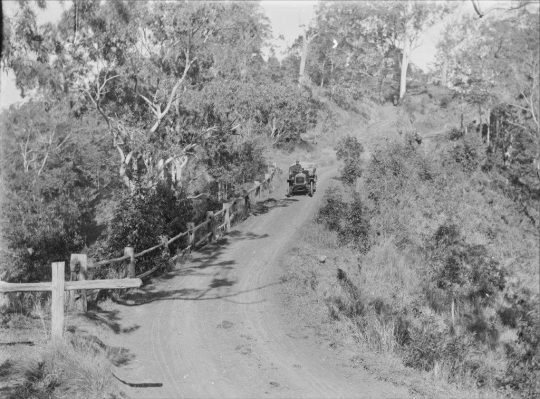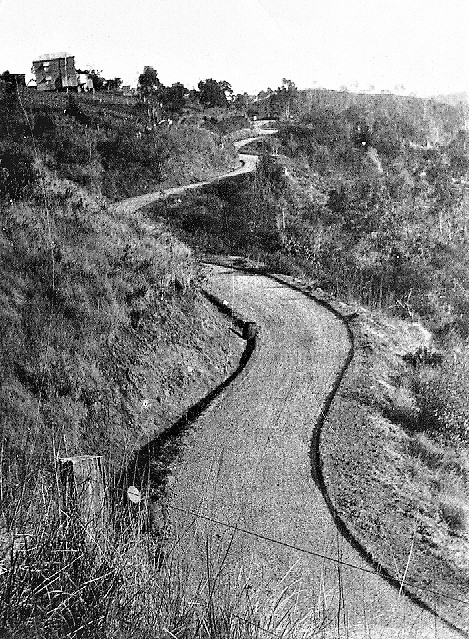Tramping the Blackalls by Vance Palmer
Daily Mail (Brisbane, Qld. 1903 – 1926), Wednesday 23 June 1926, p. 3
TRAMPING THE BLACKALLS – To Flaxton and Mapleton
A LAND OF PLEASANT ORCHARDS – Timber as the Price of Progress
By Vance Palmer
This is the last article of the series on the Blackall Range by Vance Palmer. In reviewing the pleasant orchard lands and the prosperous dairy farms the writer expressed a doubt as to whether too great a price has not been paid for the rapid rise of the district in the timber that has been sacrificed.
A new road is being built to Montville and when it is finished It ought to provide one of the finest drives in the State, rivalling that very excellent road that winds up to the heights of Tambourine. The grades of the old road are steep and though improvements and cuttings have been made on it of late years, it largely follows the direct track of 30 years ago.

At the pinch on the Razorback
The new one winds along the abrupt slopes like a snake, doubling on itself. Some idea of the country may be gained from the story that when the men working on the new road uprooted a tree, it fell nearly through a planter’s house half a mile below. It may not be true, but looking down over those steep precipices, one can almost believe it.

The Palmwoods Montville Road
Moving on from Montville towards Flaxton and Mapleton. the same view is kept within range, On the left orchards so closely packed together that one has a sense of being in a town. On the right a panorama that Intrigues the eye with its huge sweep, of distances and its infinite variety of detail. Little banana orchards are dotted all over the immediate slopes, the plants in some cases climbing up heights so steep that the lines seem almost perpendicular. From above the bananas look like small stars of green on the red soil.
POOR MAN’S INDUSTRY
Without a doubt banana growing is a poor man’s industry. Once the scrub is down the plants can be put in between the stumps and left to grow while the timber is rotting. Then the holding required is very small. A man with not much capital can have his place planted and begin to reap a return almost immediately. I have never seen better Cavendish bananas than some of these here, yet there is no doubt that powerful interests in the South have for some time been trying to create a prejudice against the Queensland banana in order to get the duties on the Fiji fruit removed. Imports from Fiji mean trade with that country, and a commercial return for someone: that is, apparently the reason for the propagandist activity. It would be a disaster to Queensland if it were successful; for the banana is a valuable pioneer. The growers who are alive to their future interests will do everything possible to combine with the authorities in rooting out ‘bunchy top’, for that disease may be made to serve as an excuse for a renewed agitation against the Fijian duties, an agitation that is already strong enough, though Queensland people hardly realise it.
ATMOSPHERE OF PROSPERITY
Flaxton has grown into being with a suddenness more surprising than almost any other part of the range. Here a dozen years ago, there were just two houses nearly hidden by the scrub and forest, Only the Dixon homestead, a big holding of several hundred acres selected in the early days, existed to give a centre to the place. Now almost every inch is occupied with neat little orchards and dairy farms, and the paspalum paddocks look as smooth as if cattle had cropped them for a hundred years. Citrus fruits give way to pineapples where the scrub turns to forest, and over all there is an atmosphere of solid prosperity. Fortunately, the Government has re served a little of this rich forest country, and at the back of the orchards and dairy farms are several hundred acres of heavy timber sloping down toward the Obi Valley. A narrow road runs from the front into as beautiful a forest as a man could wish to see. Tall gums tower overhead, rivalling the ancient monarchs of Gippsland and everywhere there are secret gullies almost hidden with tree-ferns. It is another world from that of the trim orchards along the red road. From the thick aisles of forest come the deep note of the whipbird, the call of the thrush, and the yodelling of the magpie. Further down the bullock drivers are at work hauling out the last, of the pine from the fringe of scrub along the Obi. There is not much pine left on the slopes, but there is tallowwood, grey gum, beef-wood, mountain ash, and all kinds of hardwood. Through a gap in this glorious forest we see across the valley of the Obi toward Maleny and realise what a narrow and fruitful belt of earth we have come through. On the other side is this slope toward the Obi; on the other wide vista of the Pacific. Yet. there is enough rich, volcanic soil upon this saddle to support some thousands of people in comfort and even luxury.
MONUMENT OF DAIRYING
Coming back to the road, we see by the side of it a landmark one of the pioneers has left. It is a large tree, chopped off about 40 feet from its base, and will remain for many a year as a testimony to some man’s skill and foolhardiness. Obviously, the climb of 40 feet or so was not made to save trouble; the tree is nearly as thick higher up as at the base. In chopping it from that high platform the adventurous axeman was merely making. a gesture that might easily have cost him his life. Felling timber is dangerous enough work at the best of times, but where there is skill needed there will always be men willing to take risks to prove their possession of it. From Flaxton to Mapleton. is only a matter of a few miles’ walk along a dip ping road, past orchards pink with Natal grass flowering among the orange trees. It is pretty grass, less menacing to orchards than the tough paspalum. The noxious weeds and shrubs, so marked in some mountain places, do not seem to give much trouble in these ranges. Perhaps settlement is too close to let them get a start. To be sure the lantana flourishes wherever it gets a chance, but that much more formidable pest, the blackberry has very little hold. In similar country in Victoria it has caused widespread devastation and the local councils have been powerless to check its progress, for burning and cutting seem give it a new lease of life. Unlike the lantana, it runs underground, and is as obstinate in its own way as the prickly pear.
THE FRIENDLY TREES
Breasting a slight rise we come into Mapleton, and looking at the transverse hills in the north, feel we have reached the limit of the Blackall Ranges, Mapleton is lower than Montville, and the outward view has not quite the same grandeur, for the hills slopes more gradually to the sea, and the middle distance is broken by spurs and foothills. But Mapleton has its waterfall, perhaps the striking one in the ranges, and there are delightful walks on the timbered slopes to the north. The sawmill at the head of the tramway has been working at high pressure for years, and yet around Mapleton there seems to a good deal of timber left. In this it contrasts pleasantly with Montville, where people who once hacked their way into the virgin scrub have now to buy fire wood. A few years ago, I was told, there used to be a giant beech on nearly every place as a last reserve of firewood. But the reserves have at last been called in, and now there is nothing left but the planted trees along the road, shrinking behind their palings from the night wandering cow. One of the piquant things about Mapleton is the narrow-gauge tramway that runs up from Nambour, stopping at the little sheds and depots on the downward journey to collect the fruit. So necessary a means of transport this seems that the stranger wonders why it has not been continued over the whole front of the range. Some years ago, I believe, there really was a definite plan to continue it, and tap the rich fruit country on top. Then the war happened, and the springs of money dried up.
MOTOR TRACTION
It seems almost a tragedy that such a plan was never carried to its proper conclusion, but perhaps the spread of motor traction since the war has made it less necessary. Nearly every prosperous grower has his lorry now, and on all sides, one hears people asserting that the future of this hilly country lies more in good roads than in rails. It almost seems as if the motor was ousting the railway as it has already ousted the horse. As far as the cart horse is concerned, one need shed no tears of sympathy about his passing. His life on these steep grades was never a happy one. The little tramway starts out for its daily journey down the ranges in the misty dawn. It is tempting to think of making the trip down with it winding through the banana orchards in a toy truck and drinking in the smell of the ripe fruit and the dewy soil. But the road itself is even more tempting. Who that has climbed to the top of these ranges can deny himself the walk down? Packs that have been obstrusively heavy on the upgrade become miraculously light when the road begins to dip. A cool breeze from the far-off sea blows in your face. You feel even more buoyant than at the commencement of the journey. The road down from Mapleton is one of the best walks I know anywhere. The grade Is gradual, and at every turn the country seems to change and open. After the first mile or so you feel you have already come to the level country. Looking behind; the wall of the range rises up rich and precipitous, with little incrustations of houses all along the top. Far back to Montville the eye ranges, and beyond. Through the green orchards the rails of the tramway run like a trickle of silver water, losing themselves and appearing again. On the steeper slopes, facing east, are bananas; on the others are cane and occasional patches of arrowroot. Around are flat-topped ridges, green with paspalum and filled with feeding cattle.
A LANDSCAPE SURPRISE
But this is only the first descent. The ridge narrows, and deep valleys appear on either side. You find yourself going down another slope, where the deep, chocolate soil is as rich as on the range itself. Bananas appear again, packed in among the rotting stumps. Little creeks come tinkling along the side of the road. Everywhere the vegetation has regained its tropical exuberance. So the road winds down to Nambour, shelving and gradual. There are even one or two wild granite patches, of the kind admitted to be picturesque, where the creek runs through a secret gorge. Another creek widens out through flat pastures, forming holes that yield water cress. Over the whole wide green landscape there lies a kind of idyllic beauty, the beauty of a place that seems to have been long ploughed and sown, and inhabited. This kind of beauty is perhaps what we would call un-Australian, except that we know it is just one of the surprises that Australian landscape can give us. What will these ranges be like in another 50 years’ time, one cannot help wondering as he looks back? They are not large in extent, but they are among the most fruitful places of the earth, and they have nearly everything that is desirable. A rich soil, a bracing climate, a steady rainfall, and nearness to the sea.
WATER POWER
In those falls that send streams of water down several hundrcd feet, there ought to be enough power, when they are harnessed, to supply a large district with electric light. Water power like this is generally associated with rather bleak and sterile places. Here it is to be found in a phenomenally rich one. It is easy to believe that this will be one of the most closely-settled districts in the continent within a few years, with secondary industries springing up like mushrooms around the rich, productive areas. The question remains of a forest policy for the range, if it is not too late for it. Nearly every landowner likes to think there are some trees in the district, though he usually makes his own place as bald as an egg. When this is done by every owner the result is – Maleny in a dairying district, Montville in an orange one. For one thing the bird-life is nearly banished, and yet the orchardist will admit, that birds are his most useful allies in combating different fruit pests. Then there is the matter of landslides. It remains to be seen whether the watershed of Montville can stand the clearance to which it has been subjected within the last few years, and whether the heavy rainfall will not bring about dangerous erosions. The waste of valuable timber in itself has been great. Has the district paid too big price for its rapid rise, and will the bill be presented in the future? Looking back towards Mapleton, though, as the road finally dips into Nambour, one can forget almost all the doubts and queries that force themselves into the mind at intervals during the wonderful journey. The impressions that remain are the beauty of the landscape’s sheer lines that can never be fundamentally altered, and the solid and varied work that has been done by courageous pioneers. And here is Nambour, lying within the lower hills as in a cup, and looking as if it has the right to be capital of a rich district. A solid town, with small fields of cane running along the banks of Petrie’s Creek, and little tramways converging in from all directions to the sugar mill! It is a town, with character. Coming down from the hills, it looks beautiful, with the masses of greenery, and the lines of its white bridge showing strongly through the dusk. Near at hand, one is surprised by its buildings, and the quiet taste of its shop windows that are so different in quality from what, one usually associates with a country town. At night, when the lights begin to flicker on the little hills around, it has the aspect of a metropolis. Some day it will be one— unless disaster overtakes those myriad bananas on the slopes, and the orange trees on the tops of the mountains.
TRAMPING THE BLACKALLS (1926, June 23). The Daily Mail (Brisbane, Qld. : 1903 – 1926), p. 3. Retrieved April 13, 2020, from http://nla.gov.au/nla.news-article219038196

 ©2016 Montville History Group. All rights reserved.
©2016 Montville History Group. All rights reserved.